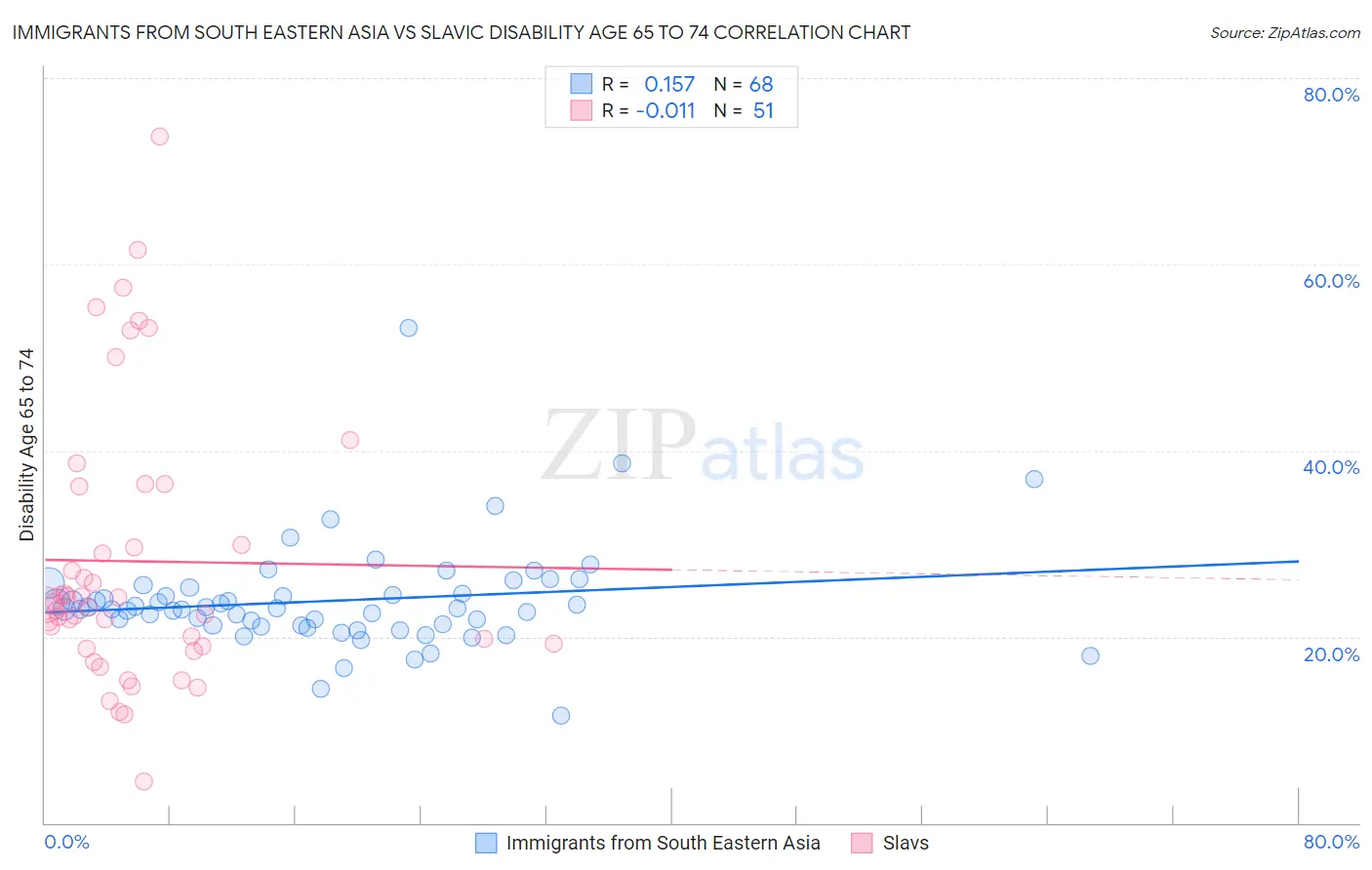Immigrants from South Eastern Asia vs Slavic Disability Age 65 to 74
COMPARE
Immigrants from South Eastern Asia
Slavic
Disability Age 65 to 74
Disability Age 65 to 74 Comparison
Immigrants from South Eastern Asia
Slavs
23.3%
DISABILITY AGE 65 TO 74
50.0/ 100
METRIC RATING
174th/ 347
METRIC RANK
23.0%
DISABILITY AGE 65 TO 74
75.2/ 100
METRIC RATING
153rd/ 347
METRIC RANK
Immigrants from South Eastern Asia vs Slavic Disability Age 65 to 74 Correlation Chart
The statistical analysis conducted on geographies consisting of 511,151,711 people shows a poor positive correlation between the proportion of Immigrants from South Eastern Asia and percentage of population with a disability between the ages 65 and 75 in the United States with a correlation coefficient (R) of 0.157 and weighted average of 23.3%. Similarly, the statistical analysis conducted on geographies consisting of 270,690,896 people shows no correlation between the proportion of Slavs and percentage of population with a disability between the ages 65 and 75 in the United States with a correlation coefficient (R) of -0.011 and weighted average of 23.0%, a difference of 1.6%.

Disability Age 65 to 74 Correlation Summary
| Measurement | Immigrants from South Eastern Asia | Slavic |
| Minimum | 11.5% | 4.4% |
| Maximum | 53.2% | 73.7% |
| Range | 41.6% | 69.2% |
| Mean | 23.9% | 28.1% |
| Median | 23.0% | 23.4% |
| Interquartile 25% (IQ1) | 21.2% | 19.0% |
| Interquartile 75% (IQ3) | 25.0% | 36.1% |
| Interquartile Range (IQR) | 3.7% | 17.1% |
| Standard Deviation (Sample) | 5.7% | 14.7% |
| Standard Deviation (Population) | 5.6% | 14.6% |
Similar Demographics by Disability Age 65 to 74
Demographics Similar to Immigrants from South Eastern Asia by Disability Age 65 to 74
In terms of disability age 65 to 74, the demographic groups most similar to Immigrants from South Eastern Asia are Yugoslavian (23.3%, a difference of 0.010%), German (23.3%, a difference of 0.030%), Dutch (23.3%, a difference of 0.040%), Cuban (23.3%, a difference of 0.11%), and Immigrants from Eritrea (23.4%, a difference of 0.14%).
| Demographics | Rating | Rank | Disability Age 65 to 74 |
| Immigrants | Bosnia and Herzegovina | 57.6 /100 | #167 | Average 23.2% |
| Pakistanis | 57.0 /100 | #168 | Average 23.2% |
| Icelanders | 54.3 /100 | #169 | Average 23.3% |
| Moroccans | 54.2 /100 | #170 | Average 23.3% |
| Cubans | 51.9 /100 | #171 | Average 23.3% |
| Germans | 50.5 /100 | #172 | Average 23.3% |
| Yugoslavians | 50.2 /100 | #173 | Average 23.3% |
| Immigrants | South Eastern Asia | 50.0 /100 | #174 | Average 23.3% |
| Dutch | 49.4 /100 | #175 | Average 23.3% |
| Immigrants | Eritrea | 47.5 /100 | #176 | Average 23.4% |
| Immigrants | Haiti | 47.5 /100 | #177 | Average 23.4% |
| Guyanese | 45.8 /100 | #178 | Average 23.4% |
| Immigrants | Sierra Leone | 45.8 /100 | #179 | Average 23.4% |
| Scandinavians | 45.6 /100 | #180 | Average 23.4% |
| Assyrians/Chaldeans/Syriacs | 45.3 /100 | #181 | Average 23.4% |
Demographics Similar to Slavs by Disability Age 65 to 74
In terms of disability age 65 to 74, the demographic groups most similar to Slavs are Sri Lankan (23.0%, a difference of 0.090%), British (23.0%, a difference of 0.10%), Immigrants from Western Asia (23.0%, a difference of 0.10%), Finnish (22.9%, a difference of 0.11%), and Canadian (22.9%, a difference of 0.20%).
| Demographics | Rating | Rank | Disability Age 65 to 74 |
| Alsatians | 83.7 /100 | #146 | Excellent 22.8% |
| Immigrants | Uzbekistan | 83.1 /100 | #147 | Excellent 22.8% |
| New Zealanders | 79.9 /100 | #148 | Good 22.9% |
| Swiss | 79.7 /100 | #149 | Good 22.9% |
| Canadians | 77.7 /100 | #150 | Good 22.9% |
| Immigrants | Morocco | 77.6 /100 | #151 | Good 22.9% |
| Finns | 76.5 /100 | #152 | Good 22.9% |
| Slavs | 75.2 /100 | #153 | Good 23.0% |
| Sri Lankans | 74.0 /100 | #154 | Good 23.0% |
| British | 73.9 /100 | #155 | Good 23.0% |
| Immigrants | Western Asia | 73.8 /100 | #156 | Good 23.0% |
| Czechoslovakians | 72.4 /100 | #157 | Good 23.0% |
| Immigrants | Vietnam | 69.1 /100 | #158 | Good 23.1% |
| South American Indians | 65.5 /100 | #159 | Good 23.1% |
| Koreans | 64.2 /100 | #160 | Good 23.1% |